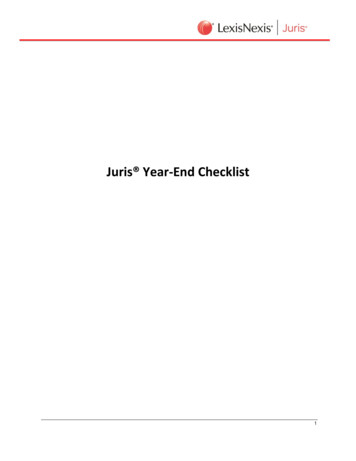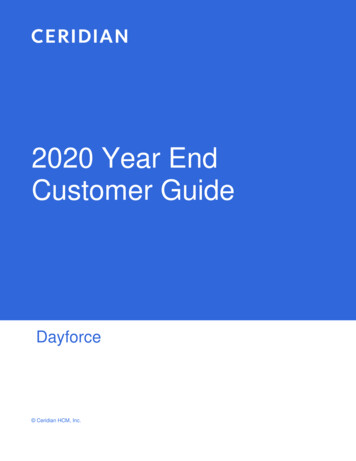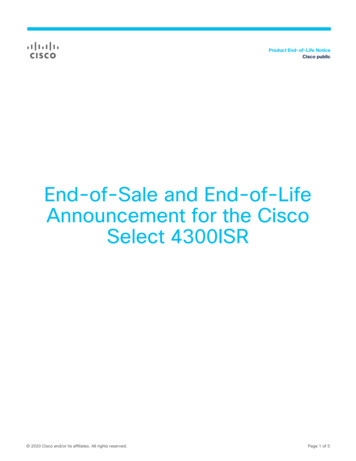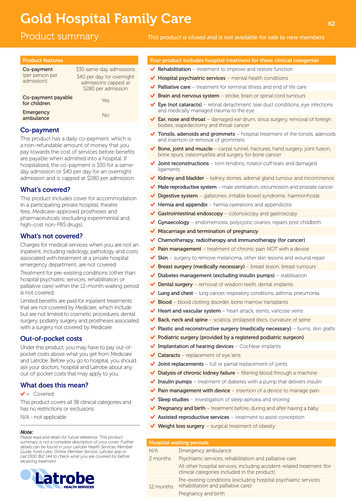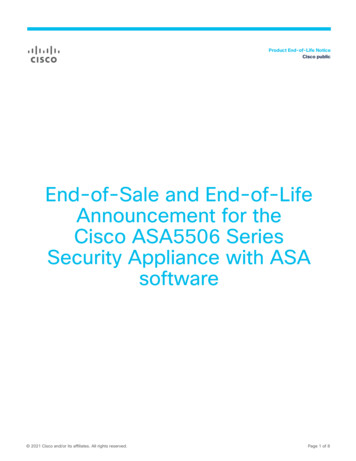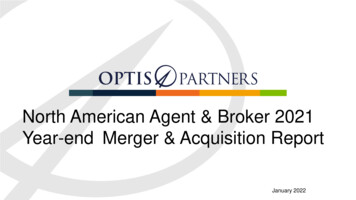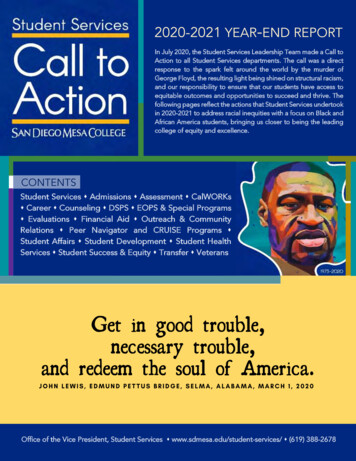
Transcription
2020-2021 YEAR-END REPORTIn July 2020, the Student Services Leadership Team made a Call toAction to all Student Services departments. The call was a directresponse to the spark felt around the world by the murder ofGeorge Floyd, the resulting light being shined on structural racism,and our responsibility to ensure that our students have access toequitable outcomes and opportunities to succeed and thrive. Thefollowing pages reflect the actions that Student Services undertookin 2020-2021 to address racial inequities with a focus on Black andAfrican America students, bringing us closer to being the leadingcollege of equity and excellence.CONTENTSStudent Services s Admissions s Assessment s CalWORKss Career s Counseling s DSPS s EOPS & Special Programss Evaluations s Financial Aid s Outreach & CommunityRelations s Peer Navigator and CRUISE Programs sStudent Affairs s Student Development s Student HealthServices s Student Success & Equity s Transfer s VeteransOffice of the Vice President, Student Services s www.sdmesa.edu/student-services/ s (619) 388-2678
LeadershipStudent Services Vice President Ashanti Hands, Ed.D.Student Affairs Dean Victoria Kerba Miller Assessment & Testing Karla Trutna, CoordinatorDiscipline Claudia Perkins, OfficerFinancial Aid Gilda Maldonado, Director; Pilar Ezeta, SupervisorOutreach Karla Trutna, CoordinatorStudent Health Services Suzanne Khambata, DirectorStudent Development Dean Ailene Crakes, Ph.D. Admissions Ivonne Alvarez, Director; Raquel Aparicio, SupervisorCounseling & Orientation Cynthia Rico, Ed.D., Chair; Andrew Tanjuaquio, SupervisorTransfer, Career, Evaluations Anne Hedekin, Transfer Coordinator; Kristy Carson andRaquel Sojourner, Career Coordinators; Olivia Picolla, Acting SupervisorVeterans & Records Ivonne Alvarez, Director; Vicki Hernandez, SupervisorStudent Success & Equity Dean Larry Maxey CalWORKs Sasha Verastegui, CoordinatorDSPS Erika Higginbotham, Coordinator/ChairEOPS Leticia Diaz, Director; Nellie Dougherty, ChairPeer Navigator and CRUISE Agustin Rivera, OfficerThe Stand Basic Needs Resource Center Johanna Aleman, Officer
Vice President, Student ServicesWe must find a way to get in the way as we stand for our students. We are the ones to create. 2020 MSSC RetreatThe Vice President for Student Services, along with theStudent Services deans, provided the vision andleadership for the 20-21 Call to Action, recognizing theurgency of racial inequity as demonstrated by the deathof George Floyd. The leadership team called StudentServices to engage in “necessary trouble” to endpractices and structures of racism where they are found.This Call to Action created a space for our work whichfocused on Black and African American students and wasundertaken by every department in Student Services. Thenext steps in our journey have just begun. We celebratethe stories of our progress as we build upon them.CALLEDOUToCREATED A SPACE1
MADE IT VISIBLEThis work is intended to be visible so that we areintentional and accountable to students and each other.Student Services’ Call to Action projects are representedin our practices and planning, are presented at MesaStudent Services Council, are featured prominently onour website and in our Student Services MonthlyUpdates, and are shared in this report.INSPECTED THE EXPECTED(& THE UNEXPECTED)VALUEDAUTHENTICITYTo address the cultural trauma of racism in theworld and where we are, Student Services holdsmonthly “Feel, Heal, and Be Real” dialogues.These encourage community-building and theauthentic expressions of our experiences. Theyalso help us return to our work more whole,empowered, and better equipped to “get in theway” on behalf of equity for students.We are all put herefor a purpose. When weare working toward ourpurpose, we are in aspace to accomplish it.We keep showing up, topull out everything inus.Ashanti Hands, 2020 Retreat2
AdmissionsWe used this year as a benchmark, a foundation on how to connect with our students, be theirinitial point of contact and then support them in their transition into other student services.Goals, Actions & Outcomes Goal: Gain Professional Learning Centering on BLM and Equityo Action: Admissions team members spent time to understand the Why of BLM andour critical equity work.o Outcomes: As an outcome of this goal, we attended over 30 professional learningopportunities, including a panel with our Black Faculty Counselors’ Collaborative(BFCC) team members who shared how they view equity in their work and practicalways we can implement equitable practices. We also benefited from –§ the Equity Crosswalk with Dean Crakes.§ Racelightning with Frank Harris and Luke Wood, including Racial Battle Fatigue,which is a framework for making sense of cognitive, emotional, andphysiological effects of being a person of color in environment that are bothimplicitly and explicitly racist.§ Bystander Traininginwhichwelearned that eachof us is an “activeparticipanteachtime [we] choosenot to step in.Each choice in notgetting involved isreinforcingthebehavior, making[us]not innocent bystander[s], but active reinforcer[s]” (Zundel).3
Goal: Remove Barriers from Black and African American Studentsoo Action: “Making it hard for students to quit”: Admissions embraced this mantra aswe worked with our new Black and African American students.Outcome: We prioritized our new Black and African American students in ouroutreach. We were intrusive in ensuring that they had the resources to besuccessful. We connected our Black and African American students with FinancialAid and Counseling team members who would support them in their goals toattend college.Goal: Become Points of ContactooUsing these goals and practices we resolved to support students by notdisengaging with them until they are connected to other support services theyneed.We made 135 personal calls/emails to 54 new Black and African American studentsfor Spring and Summer 2021.Next StepsMoving forward, we plan to continue with professional development, we have institutionalizedthe removal of barriers as we identify them and are committed to becoming the point ofcontact for those Black and African American students that we identify.4
Assessment & TestingGoalAssessment and Testing’s goal was to improve connections to new Black and African Americanstudents by creating infographics to make the assessment & testing process clearer and moreapproachable. To achieve our goals, we teamed up with Constant Contact, SDCCD PromiseProgram, and the Black Faculty Counselors’ Collaborative (BFCC) and were successful atimproving connections to new Black and African American students by creating threeinfographics.Infographics: (Milestone Info/Counseling Info/Student Resources)Actions The Assessment Supervisor met with members of the BFCC during fall and Springsemester to collaborate with and support our students who identify as Black and AfricanAmerican. The Assessment Student Services Technician created three (3) infographics toprovide students with vital student services information, milestone information, andspecial programs information.5
The Assessment & Testing Office created three graphics to help new students connectwith Counseling and appropriate Mesa College resources.The Counseling Information graphic highlighted the link “Meet Your Counselors” sostudents could click to view the counselor videos and the options available to them.The Assessment & Testing Office collaborated with Mesa’s Promise Program to screenand reach out to 25 Black and African American Year-Two Promise students.We reviewed each student’s matriculation steps, enrollment status for the Springsemester, cumulative GPA and counselor contacts to identify students who wouldbenefit from direct intervention from a counselor.OutcomesThe collaboration with the BFCC, SD Promise Program and Outreach enabled us to improveconnections to our Black and African American students. These are the results of our efforts: With the help of the Promise Program, we also emailed invitations to 72 Black and African American students to invite them to a special workshop series organized by theBFCC titled "From Registration to Graduation.”All three infographics were shared with students (approximately 580) who went throughour annual Pre-Enrollment workshops. Assessment and Outreach visited over 12 highschools this year to provide students with matriculation support.The Assessment & Testing Office supported students who attended Mesa Regfest toensure they had student services support, Placement Assistant information, ChallengeExam support, and milestone information.We will continue to update our infographics and find new ways to connect with ourBlack and African American students.6
CalWORKsGoalOur Call to Action response called for the intentional review of our efforts to support Black andAfrican American students in order to ensure that they are informed and, where appropriate,enrolled in resources and other Mesa College programs.Actions We updated our program intake form to include an ethnicity identifier that allows us tointentionally reach out to Black and African American students and refer them to themultiple services Mesa College has to offer, including Mesa’s BLM Resource Website, theUMOJA program, EOPS, NextUP counselors who offer direct support, and the BlackFaculty Counselor Collaborative (BFCC). In addition to those referrals, we promote and refer all of our students to other equityprograms and services on and off campus through our monthly CalWORKs newsletterand CalWORKs Canvas shell. These include o The Stand: Basic Needs Resource Centero EOPS & Special Programs: CARE, STAR TRiO, NextUp, FAST Scholars, and ProjectRestarto DSPSo CARES ACT / COVID-19 Emergency Relief Fund & Supporto Veterans Success Center (if applicable)o Online Learning Resourceso Mesa Tutoring (MT2C)o Mesa Journeyso Scholarships (on and off campus) Our CalWORKs counselors and program coordinator received professional learning andattended conferences centering on confronting biases and providing equitable andinstructionally sound services to Black and African American students.7
Career CenterActions & GoalsTo increase career exploration access and engagement for Black, African American, and Latinxstudents and to dismantle career planning inequities – the Career Center counselor, co-coordinators, and student support specialist partneredwith instructional and support programs like Black Studies, Chicana/o Studies, UMOJA &Puente to provide Career Center presentations to Black and Latinx students. the Career Center and Peer Ambassadors encouraged Black and Latinx students toexplore careers at events and through presentations, counseling, and peer-to-peereducational opportunities. the Career Center team participated in the creation of the Transfer, Career and EvaluationDepartment’s Antiracism, Diversity, Equity, and Inclusion Plan.OutcomesThe Career counselor/coordinators have been more intentional about career outreach. As ofSpring 2021, they conducted five meet and greet/career presentations to over 100 students inthe following courses Personal Growth 120 Puente Black Studies 100 and 140A Personal Growth 140 UMOJA course/event for Black Student Success WeekThe Career Ambassador Program (CAP) engaged in meaningful connections with 119 students.Notably, at the Spring 2021 Career Peer Workshop Series, the Career Peer Ambassadors createdand facilitated six career-related workshop presentations aimed to help students learn about jobsearch strategies, interview preparation and networking in a virtual environment, essentialpersonal branding tools, and career readiness skills and resources.Lessons Learned & Next StepsAlthough our student turnout was amazing for the events held, only 7 of 119 participants selfidentified as Black or African American. Among the 119 participants, the following self-identifiedin the other racial and ethnic groups 9 Asian/Pacific Islander 11 Hispanic/Latinx 8 White/CaucasianWe hope to reach more African American/Black students by creating and sharing a newsletterwith hyperlinks for the students to access the workshop presentations and session recordings.8
CounselingGoalsThe Counseling Equity Committee, composed of Jennifer Phelps, Vang Thao, AdamErlenbusch, Kristy Carson and Leroy Johnson, met to plan activities, make reports to theCounseling Department at Counselor meetings, and create the monthly updates to ourdepartmental Call to Action.ActivitiesThe Committee planned the following activities - Student Engagement/Experience: “Welcoming Environment”Professional development/Awareness: “Open House” and “Counseling ConnectionNewsletter”Removing Barriers: “Technology”Outcomes Student Engagement/Experience: “Welcoming Environment”o “You Matter” effort to outreach to the newly attending spring 2021 group of Blackand African American students. All counselors reached out to their group of 4-5students. 89 students were e-mail at the beginning of February of 2021. Eligiblestudents not enrolled in EOPS were invited to apply. The BFCC met with 86students at hotspot and ed planning events.Professional Learning/Awareness: “Open House”oIn early spring 2021, the Counseling Department invited faculty from Black Studiesand Chicano Studies as well as students from in those programs to share ideas onhow the department can better serve disproportionality impacted students. As such,the idea of having an OPEN House was proposed by the panelist after hearingstudent stories that faculty are not aware of support services offered at Mesa. Casein point, the instructional faculty appeared to not know what is offered by theGeneral Counseling Department. Taking the idea from the panelist, the Departmentoffered an Open House targeted to instructional faculty. The goal was to informfaculty of pertinent information so they could impart with the students in theirclasses. A secondary goal of the OPEN house was to also showcase how ourCounseling faculty service Mesa’s disproportionality impacted students through ourPersonal Growth Courses, Puente Umoja and Black Faculty Counselor CollaborativeHot Spots.9
“Counseling Connection Newsletter”o To-date two editions have been published, and the third quarter edition is on itsway. The newsletter includes “Counseling Hacks,” (e.g., How does P/NP gradingwork?, the honors program, how to request transcripts evaluation, how to clearprerequisites) to support disproportionately impacted students and lead them toservices that can be expedited without really having to see a counselor and torelevant programs.Removing Barriers: “Technology”ooThe department felt that we could be more responsive to students’ needs duringstudent/counselor interactions. The questions asked included:§ “Did you feel your voice was heard in your General Counseling drop-in time orscheduled appointment? Please explain ”§ “Were there any barriers to accessing a counselor?”§ “During the General Counseling session time, what did we do well and wheredo you think we can improve?”150 responses were submitted which resulted in two innovations:§ First, the department now clears prerequisites in a more expedient mannerthrough the use of a dedicated email address -- sdmesaprereqs@gmail.com.§ Second, A new Google form was created in April 2020 to request transcriptevaluation. So far, more than 400 students have benefitted from this innovation.Lessons Learned Student Engagement/Experience: “Welcoming Environment”oo Professional development/Awareness: “Open House” We wanted to have a bigger turnout and are now working to have a spring 2021version of the Open House concept.“Counseling Connection Newsletter”o A rallying point for all counselors. There was total buy-in by everyone, andincluded follow-up by many with those same studentsThere is also a smaller goal to have student artwork displayed in Counseling areaswhen we return to campus.This has become a huge vehicle to highlight KAPWA/UMOJA/PUENTE, and otherequity efforts that the department is involved in.Removing Barriers: “Technology”oThe department has shared the “Share Your Voice” resource with other areas bothat Mesa and on our sister campuses. We have found that this feedback system isgiving students a chance to critique our services. When we first began ourCounseling ‘Call to Action’, we held a student panel, and students felt that theyneeded to be welcomed in a much more global way, and that the CounselingDepartment needed to be more student friendly. This survey open to all studentshas been a great way for us to be in touch with what students are asking for.10
Disability Support Programs & Services (DSPS)“I just want to take a moment to say thank you forall your kind and encouraging words.” –DSPS StudentDSPS Department Goals and Actions DSPS –oooooohas been intentional with our language through our Words Matter campaign,changing “intake” appointments to “welcome” appointments and leading efforts toadopt this change districtwide.allowed for flexibility on eligibility while including students in the process.accepted online appointment requests and applications.was represented on the Black Faculty Counselor Collaborative (BFCC).actively participated in trainings, webinars, and workshops that were grounded inequity practices for counseling and serving Black and African American students.continues to provide opportunities for campus community members to educatethemselves about the intersection of racism and disabilities, and the impacts ofracism on individuals with disabilities at San Diego Mesa College.Moving Forward DSPS will –oooenhance marketing and awareness of the supports DSPS provides.provide additional training for faculty on the intersection of racism and disabilities.increase opportunities for students to feel engaged and supported as part of theSan Diego Mesa College and DSPS community.11
EOPS & Special ProgramsGoalThe EOPS & Special Programs Department will increase EOPS eligibility of Black/African Americanstudents during the 2020-2021 academic year.OutcomesEOPS and Special Programs served 77 more Black and African American students from 2019-2020 to2020-2021. The data, below, provides a snapshot of some of the efforts that supported the goal ofincreasing EOPS eligibility of Black and African American students.EOPS Eligible and Completing EOPS Requirements: Number of Black or African American Students Served2018-2019722019-2020802020-2021157*Sources: Data Dashboard and *EOPS internal records.GenderCitizenshipGPAProgram tizen3.54.03.03.52.53.002.5CARENextUp *7*8*Sources: Campus Solutions and *EOPS internal records.An EOPS team member called each student that hada pending application.Applied / Not EligibleFall 2020Spring 20214524Reasons for Ineligibility: Missing transcripts,residency, campus of record not Mesa, and/or hasn’tmet financial aid requirement.Outreach and In-Reach Query with Ethnicityo Ethnicity was added to EOPS query. EOPS has always collected ethnicity from the EOPSApplication. Ethnicity was also initially listed on EOPS page when Campus Solutions wascreated and then removed. We requested this data to be added again on the EOPS pageso that ethnicity information be available through query and pulled through student recordon Campus Solutions.o While this query was being updated to include ethnicity, we collected ethnicity through theFall 2020 EOPS Exit Survey. Students were able to self-identify by typing in their response.This is a summary of some of the ethnicities that students shared: African, African American,Black, African-American/White/Filipino, Afro Caribbean, Black/African American/White,12
Black/Pacific Islander, Black/Mexican/Irish, African/Native American, African/Portuguese,African American/Mexican American (Source: Fall 2020 EOPS Online Application).Query with Potential EOPS Studentso District sent outreach emails to students that have a campus of record at Mesa, enrolledin 6 or more units, with CCPG on file inviting them to apply to EOPS.List from Financial Aido Financial Aid also provided our department with a list of Black/African American studentsthat have a campus of record at Mesa college and enrolled at Mesa College. EOPS Teammember emailed and called students that had not yet applied to EOPS to ensure thatthey applied.Wellness Check-inso EOPS Team member conducted Wellness Check-ins with all current EOPS eligibleBlack/African American students to answer any questions that had, provide resource andscheduled appointment to complete their program requirements.Outreach Emails and/or presentationso UMOJA-Mesa Academy, Black Studies, Athletics, Learning Communities, Black StudiesDepartment, and sent global email.Website and Social Mediao Updated website and social media page regularly so that prospective and currentstudents can learn about the latest information.o Social Media presence increased, and followers increased from 200 to 900.Workshops and Reminderso Offered several workshops throughout the year. We also collaborated with otherdepartments such as Health Services, Work Based Learning, Honors, Student Affairs andSDSU to offer different workshops. Workshop topics were proposed by EOPS teammembers based on interactions with students and by requests from students. Workshopsare open to all students. Information below includes and is not limited to the workshopsand reminders provided for students. Information is posted on Instagram and also sentto students via email.Workshop and Reminder ExamplesApplicationInformationSessions & Meetand Greet 1, 2, 3HonorsUniversityApplication1, 2, 3Financial Aid1, 2Wellness1, 2, 3, 4, istration1, 2ScholarshipApplicationStudentAchievementPosts1, 2, 3, 4Reminders weresent by emailand Instagram.13
oProfessional Learning Opportunitieso Professional learning continued to be offered to EOPS team members through platformssuch as the CCCCO Vision Resource Center, Go2Knowledge, Student Services: Feel, Healand Be Real, LOFT, CCCEOPSA, Region X EOPS, A2MEND, and many more.Testimonies“These services helped me get a head start and allowed me to get in classes that I wanted withouthaving to make a second choice!”, “Kept me clam during this time felt i had support”, “They arethere to make sure we get the extra support and good to have check in”, “It helped make school alot less stressful”, “I was unable to pay for my books and had to drop classes with out the help fromeops I would have skip this semester”, “Being the advocate by emailing people for me.”, “Theyhelped me stay focus and on track.”, “Help me to move forward throughout my classes.”, “sendingme emails about helps that I could get if COVID-19 was affecting me or my family”, “They alwaysstay on top of me and check on me.”, “They let me know about zooms to connect with my peers andfaculty.”, “They help me find links to better help whatever situation I’m going through.”, “They werealways there to help answer all my questions”, “EOPS helped me succeed mostly through theirfinancial services this year and priority registration.”, “I really enjoyed being apart of this program, itnot only helped me financially with materials and cost for choosing, but gave me the guidance Ineeded.”, “Definitely gave me a better understanding of how to enroll and navigate througheverything.”, “Eops has constantly offered counseling and a lot of resources with workshops andmore.”, “Help me to figure out which universities I should transfer for my major”, “It helped me knowthe right classes to take. Emotionally, that I'm not alone.”, “I felt supported and encouraged”, “Whenever I needed guidance some was always available in a timely manner to assist me. The team is everysympathetic and empathetic my needs and understanding”, “Book service was beneficial because Ididn’t have to worry about the book cost. I find the priority registration to be most beneficial so thatstudents are able to get the classes they need. Workshops and events were beneficial as well,providing support and a sense of community through rough times.” (Source: EOPS Exit SurveyResponses)Takeaways The power in collaboration and collective efforts in serving disproportionately impactedstudent populations. We are stewards and of service of communities so that communities are at the forefrontof naming their need and moving towards a path of liberation through higher education. Create a transformational experience by amplifying student voices, and by providing andoffering an array of programs and services. Community is guiding their path; we arestewards to this purpose. Expected outcome of the transformational experience is from the community and by thecommunity. Continue dismantling systems of oppression and creating transformational spaces.14
EvaluationsGoalsDue to historic and structural racism and other forms of systemic barriers for Black and AfricanAmerican students including lower graduation numbers, the Evaluations department at SanDiego Mesa College is committed to closing the gaps between the number of students eligiblefor a degree and or certificate and the number of degrees and or certificates actually awarded.ActivitiesTo increase the percentage of Black students obtaining a degree/certificate, Evaluations has – hosted Graduation Application Parties to explain the application process, the importanceof earning a degree and/or certificate, and the importance of participating in theCommencement Ceremony and the Rite of Passage end-of-the-year celebration. helped remove structural barriers created by some student petitions. participated in the creation of the Transfer, Career and Evaluation Department’sAntiracism, Diversity, Equity, and Inclusion Plan.Outcomes“Apply to Graduation” parties were held in a virtual format and included information about howto apply to graduate. In addition to explaining the graduation application process and promotingthe importance of participating in the Commencement Ceremony, the Evaluations team sharedinformation about career services available to students and alumni and the value of earning adegree on a resume. A total of 4 “Apply to Graduation” partied were held as of the end of Spring 2021. A total of 60 students participated in the 2020-2021 academic year. Students shared how helpful the event and resources were during their last yearcompleting their degree. Additionally, all student petitions and forms are now electronic. Most petitions requirestudents to meet with a Counselor before submitting.Lessons LearnedAlthough student turnout was good for these first-time virtual events, additional outreach needsto focus on our Black, African American, and Latinx students since their attendance was lowerthan expected.15
Financial AidGoals1. Increase the number of Black and African American students who are both enrolled andnot yet enrolled and who apply for Financial Aid.2. Among these students, increase the number who complete their Financial Aid file.ActionsFinancial Aid – requested queries from District to collect data for the goals, above. reached out to students with the help of Outreach to meet the first goal. reached out to students to invite them to complete their financial aid files and participatein the Financial Aid Check-Ins twice a month to meet the second goal. added a sign-up form and flyer for the Financial Aid Check-Ins on the Student Servicesmain web page to meet both goals.sent out an email invitation four times a month to between 1,200-1,455 students whoidentified as “Black African American.” The outreach numbers varied based on termenrollments.Query DataDependentIndependentEnrolled in SU21Met SAPDid Not Meet SAPMet SAPDid Not Meet SAP388164424476111Success79%Check-In OutcomesTotal ParticipantsCompleted FilesIncomplete FilesNo FAFSA29215316
Lessons Learned WehadindividualZooms set for eachstudent, but it did notprovide the outcomewe wanted. Out of theeight students from 1stmonth,onlyfourshowed up to our Zoommeeting.We changed to phonecall appointments andthat has been verysuccessful. Out of the29 students who madeappointments,theFinancial Aid supervisorwas able to speak/meetall 29 students, whichinclude the first eight.Having a FA Check-inbi-weekly has been verysuccessful; however, wesee a need to increasethe visits to weekly.Next StepsIn collaboration with the Black Faculty Counselors’ Collaborative, tailor a specific appealsworkshop to the FA Check-Ins.17
OutreachGoalsOutreach’s goals were to collaborate with the Black Faculty Counselors' Collaborative (BFCC)liaison to best support our Black and African American Promise students, increase Black andAfrican American student participation in Promise-led events, and connect incoming Black andAfrican American students to Mesa College’s resources and services.Actions To achieve our goals, we teamed up with the Black Faculty Counselors’ Collaborative. We met with members of the BFCC during the fall and spring semesters to collaborate and support our SD Promise students who identify as Black and African American.We created a plan to increase outreach to incoming Mesa College students who identify asBlack and African American and connect them with support services and programs.We surveyed our SD Promise cohort 20-21 (Year 1) and cohort 19-20 (Year 2) to acquiredemographic data. These were the results:o Year 1 – 52 students self-identified as Black/African Americano Year 2 – 26 students self-identified as Black/African AmericanWe invited high school students, Continuing Education students, and community membersto our “Path to Mesa,” which included information about Umoja/Mesa Academy.We invited high school students to Umoja info sessions.We held a training session for our Outreach Ambassador team.We connect all Black and African American students
the Career Center counselor, co-coordinators, and student support specialist partnered with instructional and support programs like Black Studies, Chicana/o Studies, UMOJA & Puente to provide Career Center presentations to Black and Latinx students. the Career Center and Peer Ambassadors encouraged Black and Latinx students to



